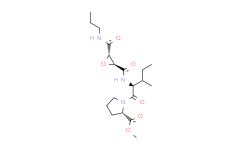| Cas No.: | 147859-80-1 |
| Chemical Name: | Methyl (2S)-1-[(2S,3S)-3-methyl-2-[[(2S,3R)-3-(propylcarbamoyl)oxirane-2-carbonyl]amino]pentanoyl]pyrrolidine-2-carboxylate |
| Synonyms: | L-Proline,N-[[(2S,3S)-3-[(propylamino)carbonyl]-2-oxiranyl]carbonyl]-L-isoleucyl-, methylester;(S)-Methyl 1-((2S,3S)-3-methyl-2-((2S,3S)-3-(propylcarbamoyl)oxirane-2-carboxamido)pentanoyl)pyrrolidine-2-carboxylate;CA-074 ME;L-TRANS-EPOXYSUCCINYL-ILE-PRO-OME PROPYLAMIDE;(L-3-trans-(Propylcarbamyl)oxirane-2-carbonyl)-L-isoleucyl-L-proline methyl ester;CA074 methyl ester;CA-074 methyl ester;CA074Me;CATHEPSIN B INHIBITOR IV;L-trans-Epoxysuccinic Ile-Pro-OMe Propylamide;L-trans-Epoxysuccinyl-isoleucyl-proline methyl ester propylamide;CA-074(OME);L-trans-Epoxysuccinyl(propylamide)-Ile-P;(L-3-Trans-(propylcarbamoyl)oxirane-2-carbony;L-TRANS-EPOXYSUCCINYL (PROPYLAMIDE)-ILE-PRO-OME;N-((L-3-TRANS-(PROPYLAMINO)CARBONYL)-OXIRANE-2-CARBONYL)-ILE-PRO-OME;L-trans-Epoxysuccinic Ile-Pro-OMe Propylamide;CA 074Me;Methyl (2S)-1-[(2S,3S)-3-methyl-2-[[(2S,3R)-3-(propylcarbamoyl)oxirane-2-carbonyl]amino]pentanoyl]py |
| SMILES: | O1[C@@]([H])(C(N([H])C([H])([H])C([H])([H])C([H])([H])[H])=O)[C@@]1([H])C(N([H])[C@]([H])(C(N1C([H])([H])C([H])([H])C([H])([H])[C@@]1([H])C(=O)OC([H])([H])[H])=O)[C@@]([H])(C([H])([H])[H])C([H])([H])C([H])([H])[H])=O |
| Formula: | C19H31N3O6 |
| M.Wt: | 397.4659 |
| Sotrage: | 2 years -20°C Powder, 2 weeks 4°C in DMSO, 6 months -80°C in DMSO |
| Description: | CA-074 methyl ester is a specific inhibitor of Cathepsin B, which has potent bioactivities such as neuroprotective, anti-cancer, and anti-inflamatory effects. |
| In Vivo: | Hippocampal CA1 neuronal programmed necrosis induced by global cerebral I/R injury is prevented by CA074-me (1 μg, 10 μg) both pre-treatment and post-treatment. The rupture of lysosomal membrane and the leakage of cathepsin-B, and this is strongly inhibited by CA074-me pre-treatment. The overexpression and nuclear translocation of RIP3 and the reduction of NAD+ level after I/R injury are also inhibited, while the upregulation of Hsp70 is strengthened by CA074-me pre-treatment[1]. CA-074Me (30 mg/kg) is capable of inhibiting osteoclastogenesis and bone degradation in vivo[2]. In the CVB+CA-074Me (4 mg/kg/day i.m.) guinea pigs group, the scores of inflammation significantly decrease in comparison with the CVB+None group. In CVB+CA-074Me group, the number of CD8+T cells decrease in comparison with the sham group[3]. |
| In Vitro: | CA-074Me (5 μM and 50 μM) inhibits RANKL-induced osteoclastogenesis in BMM cells derived from C57BL/6J and NOD/ShiLtJ mice. CA-074Me exerts its anti-osteoclastogenic effect within 24 hours post-RANKL stimulation in vitro. CA-074Me does not exert its anti-osteoclastogenic effect via the MAPK-ERK signaling cascade. CA-074Me inhibits c-FOS upregulation and subsequent NFATc1 autoamplification following RANKL stimulation.[2]. CA-074Me reduces apoptosis induced by CVB1[3]. |






















